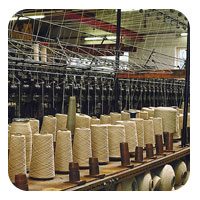The Rise of Factories
The rapidly growing American population fueled an economic transformation toward mechanization and factory production.
Before the War of 1812, manufacturing in America occurred on a small scale. Skilled artisans worked in their homes or shops, producing a limited number of goods for a local market. Women, similarly, worked in their homes producing finished textile goods. Master craft workers passed on their knowledge to journeymen and apprentices seeking to learn a trade.
In 1799, Eli Whitney introduced the concept of interchangeable parts. He developed machinery that mass-produced parts that could be used interchangeably in the rifles he was assembling. This idea of mass production spread. In 1813, New England merchants formed the Boston Manufacturing Company and opened a textile factory in which machines driven by water power accomplished the entire spinning and weaving process.


The Boston Manufacturing Company expanded its operations and set up a new mill in Lowell, Massachusetts. The company hired young unmarried women to run the machines at the factory, which became the most famous textile manufacturing plant in the country. Factory owners sought women and children to work in the factory since they were fit for wage labor, unlike men, who were supposed to be economically independent. The female workers resided in boarding houses, where they lived under the watchful eyes of matrons. At work, the women endured long tedious hours performing the same task over and over for little pay. It was widely assumed that the "Lowell Girls'" income provided only a supplement to family income.
Textile mills sprang up throughout New England. This growing competition led factory managers to speed production and increase output. The factory system eventually spread to shoemaking and other industries. Artisans could not match the speed and or low pay of early factory production. Craft workers and apprentices had to close their shops and take jobs in factories, sometimes working as manual labor. The factory had changed manufacturing in America.
 |
Read Harriet Hanson Robinson's account of her experiences working at the Lowell textile mill. |